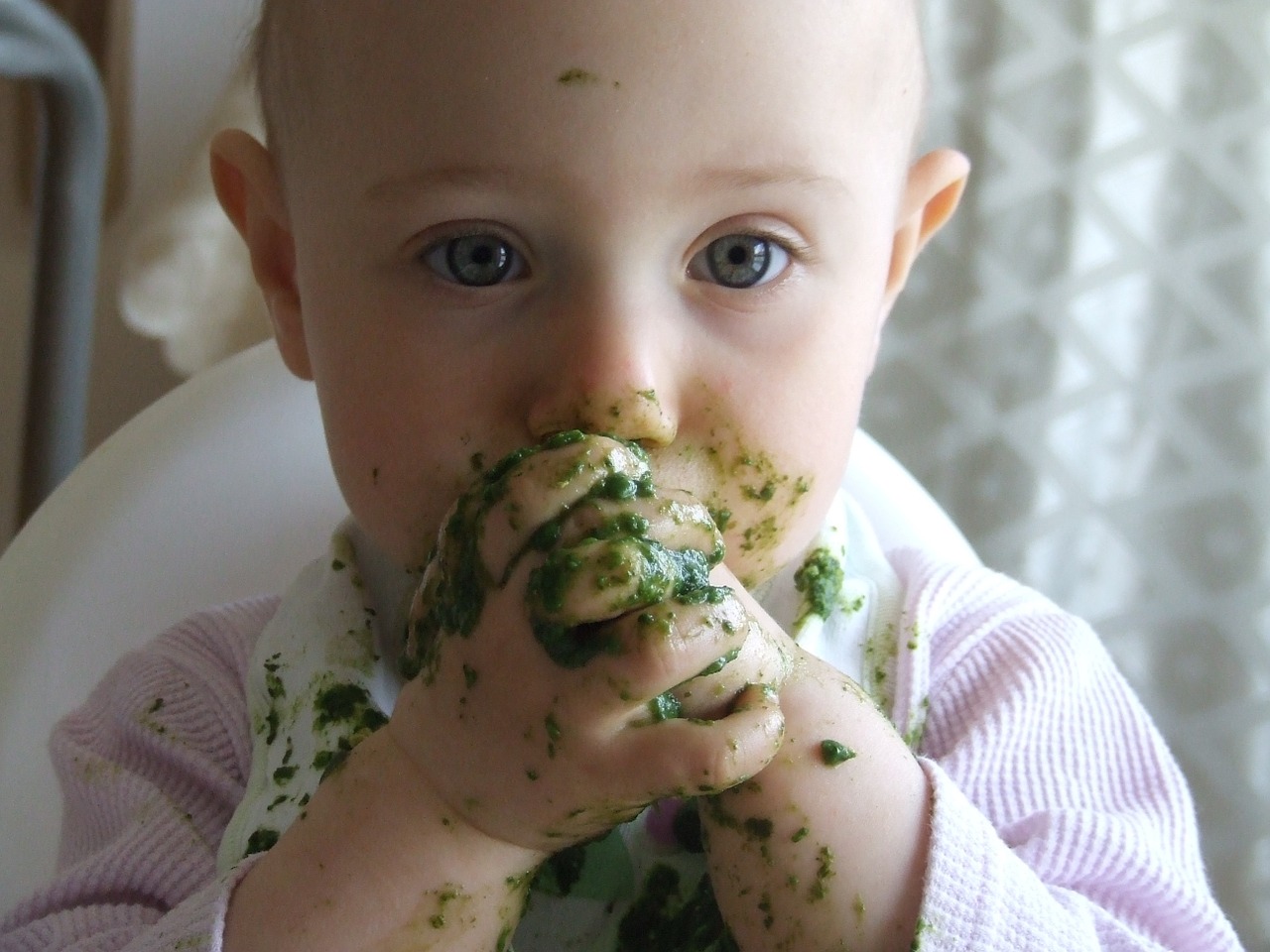
26 Oct Let’s start a baby-led, “complementary food” plan for your baby!
Introducing Your Baby to Food
At around 6 months, babies who have been nourished by only breast milk or formula since birth are about ready to start transitioning to solid foods.
In Japan, babies’ first foods are called “weaning foods.” But what does “weaning” mean? Do all babies have to be “weaned” completely from breast milk or formula at 6 months?
No, that’s not quite what it means. Even though babies are starting to practice eating and their bodies are able to eat solid foods, they still need breast milk or formula because babies still cannot fully meet their nutritional needs through eating alone. Completely “weaning” your baby isn’t necessary yet.
What does “weaning food/complementary food” mean?
Instead of “weaning food”, the term “complementary food” is now more commonly used. The word “complementary” means “to make something complete by supplementing something.”
The various nutrients that are needed more and more as babies grow cannot be sustained through breast milk or formula alone, so babies have to eat food to make up for that lack.
Of course, in the meantime, breast milk or formula is still the main source of nutrition for babies, so there is no need to reduce them.
And as for complementary foods, there is no need to keep feeding your baby foods that are less nutritious than breast milk or formula.
When should I start?
- The standard age to start is around 6 months old.
- The baby can sit up straight at the table with little support.
- The baby is interested in adult food and reaches for it.
- The baby shows interest in adult food and copies the way adults eat.
If you notice these signs, it’s probably a good time to start.
There is no need to force your baby to eat when he or she is in a bad mood. Babies do not yet understand that complementary foods will fill their stomachs. If they are crying because they are hungry, first, give them milk.
What foods should I start with?
Nowadays, there is an approach in which the parents don’t need to start with pureed foods, but instead they give their baby textured foods in reasonably sized pieces right from the beginning.
This alternative method is called Baby-Led Weaning (BLW).
What is Baby-Led Weaning (BLW)?
Like you might imagine from the name, this method is a “baby-led” complementary diet. Babies grab and hold the food with their own hands, bring it to their mouths, and eat it by themselves.
The baby decides the pace, amount, and order of eating.
It’s better to start with complimentary foods that are more solid in form and can be easily grabbed by the baby.
 Disadvantages of BLW
Disadvantages of BLW
It gets messy! Food can get everywhere: from the baby’s hands, face, head, and other parts of the body to the baby’s clothes and bib, and even the area around the table, the highchair, and the floor! Sometimes even the adult’s clothes, too.
(But this may not be just for BLW.)
In the beginning, you might not know how much your baby has actually eaten between them dropping it, playing with it, or taking it out of their mouth…
 Advantages of BLW
Advantages of BLW
- The baby’s motivation is valued, while the baby gets to enjoy the taste, texture, color, and smell of food.
- Babies copy their parents, which leads to them learning and developing their ability to eat.
- BLW promotes the development of chewing ability, hand and finger movement, and hand-eye coordination.
- Parents don’t need to prepare special food for the baby, which saves time in the kitchen and helps the family enjoy meals together.
This method seems to go reasonably with the baby’s development.
Differences between conventional weaning methods and BLW
Who takes the initiative?
Using conventional weaning methods, parents spoon feed their baby a puree or paste food that is completely different from what adults eat.
This “parent-led” approach leaves it to the parents to decide what their baby eats, the order in which they eat, portion size, and the pace.
Click here to see![]() conventional weaning methods
conventional weaning methods
(!) Using the BLW method, the choice lies with the child. The baby decides what to eat, in what order, how much, at what pace, and when they are finished eating. Even if your baby eats with a spoon, they take the initiative. ( This doesn’t mean that the food has to be solid food.)
What does your baby focus on at meal time?
Conventional methods have parents delivering food to babies who then automatically put that food into their mouths. So, babies do not have to concentrate on the food and their eyes focus on their parents.
(!) In BLW, babies bring food to their mouths by themselves. They will observe their food closely because the food is in front of them. They focus on the food on their own.
Everything is baby-led, so it’s natural that things won’t always go the way parents want or expect. There is no need to push babies to eat everything in front of them from the beginning. Parents should not “make them eat,” but instead “show them how to eat.” This will help babies learn to eat well on their own.
What to be careful of with complementary foods 1:
 What to avoid:
What to avoid:
- No honey for babies until they are one year old.
Honey can contain a bacteria called Clostridium botulinum, which can cause infant botulism.
- No foods that contain excessive amounts of salt or sugar.
Babies’ kidneys cannot yet process a lot of salt. Sugar can cause tooth decay and negatively affect learning the natural flavors of foods.
- No foods that might get stuck in the baby’s throat or that they can choke on. For example, hard and insoluble nuts, sticky foods such as rice cakes, and whole, small, round foods such as grapes can all present a danger.
- No raw foods
Anything that is not cooked sufficiently can cause an upset stomach or gastroenteritis in babies. In addition to raw foods, avoid giving natural cheeses, cured ham, and smoked salmon, etc. to your baby.
- No food with a high caffeine content
The stimulant can affect a babies’ mood.
It is also advisable to avoid artificial seasonings, artificial colors, preservatives, artificial sweeteners, and other additives.
What to be careful of with complementary foods 2:
For safety:
- Have your baby sit up straight facing the table.
You can also have your baby sit on your lap. Reclining or leaning on anything is dangerous for your baby. If your baby needs a little help sitting in their highchair, use a bath towel around their waist for support.
- Keep an eye on your baby
Always watch babies while eating, and do not leave them alone. Also, do not put anything babies cannot eat within their reach.
- Be mindful of your baby’s pace.
Don’t distract your baby, rush them, or put food in their mouth without asking.
- Take time to cut round foods in half.
Rounded foods can easily get stuck in the throat and pose a choking hazard, so cut them in half or quarters, or cut food into half-moon slices instead of round slices.
- Pay attention to temperature
The center of the food may be hot, especially if it has been heated in a microwave oven. Check not only the surface but also the inside.
About Allergies
When introducing common allergy foods such as eggs, milk, wheat, soybeans, etc. to your baby, start with small portions the first time, and carefully observe your baby afterward.
When introducing eggs, it is best to try in the following order:
- Start by giving hard-boiled egg yolks. If that is okay,
- Give hard-boiled egg whites.
If your baby has any symptoms that concern you, please consult your pediatrician.
Let’s try BLW
Step 1
(!) First, it’s best to start only when sure that the baby is ready and excited to eat at the same time as adults.
Put the food in a place where the baby can see it and reach it, and let the baby reach out for the food freely themselves.
Don’t worry so much about the food’s nutritional balance for now. First, let’s try foods that babies can easily hold and aren’t too hard to chew.
The ability for babies to pinch food with their fingertips and other motor skills will come later. Initially, babies will only be able to put the part of the food that sticks out of their hand into their mouths, so foods should have a part that will serve as a handle for babies to hold. Foods will also need to be longer than the length of the baby’s fist.
Boiled vegetables and peeled fruits are some foods that babies can easily hold. Apples and other foods that seem too hard for babies to chew can be placed in the microwave to soften them. Meat that is not fibrous and is tender can also be a good option.
 (Easy to hold♥)
(Easy to hold♥)
When you first begin BLW, consider it more as time for babies to play and learn, rather than as the time for babies to eat. Instead of expecting babies to eat a lot, think of it as fun, family time.
Step 2
Given the opportunity, babies practice and learn independently, and they become able to do more and more things on their own.
As they grow and develop, let’s allow babies to try new things.
Even babies who initially only scatter and play with their food will gradually be able to eat properly. And as they touch and learn more objects, they will be able to pinch things with their fingertips rather than just hold them.
It’s a good idea to pay attention to the development of the baby’s motor skills and make pinch-sized portions from stick-shaped foods or soak or dip foods in something to allow babies to try different ways of eating and various food shapes.
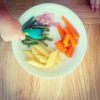 You can use tableware, such as plates, though in the beginning, placing the food directly on the table is fine, too.
You can use tableware, such as plates, though in the beginning, placing the food directly on the table is fine, too.
If babies want to copy adults, and hold or use spoons or other utensils, that is OK.
(!) Ball-shaped foods that can potentially cause the baby to choke are a “no.”
♫ I want to try!♫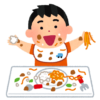
You might feel the need to intervene before the baby makes a mess or spills their food, but it is important to let babies progress at their own pace, and allow them to freely learn for themselves. To make cleaning easier, you can lay a sheet under the baby’s chair and have them wear clothes that are easy to change (if it’s not too cold, the baby can just be in their undershirt and/or diaper).
Step 3
As they are able to eat more varieties of food, it’s time to consider making sure babies get the nutrients they need.
For babies to grow, they need plenty of energy. If proper portions of grains, protein, vegetables, and fruits are fed to babies, it will be easier for them to get the energy while receiving a proper balance of nutrition. When babies are born, the iron that was stored in their bodies gradually depletes. Therefore, it becomes important for babies to receive proper amounts of iron through their foods as well.
⦿ Main dishes
Soft rice, fried rice, Japanese vegetable stuffed dumplings (similar to gyoza oyaki), spaghetti, udon noodles cut into 5cm pieces, sticks of toast
⦿ Protein dishes
Thinly sliced grilled meat, omelet, cut boiled eggs, cheese, shredded chicken, tiny boiled shirasu fish, grilled fish, tofu steak
⦿ Vegetable dishes
Vegetable sticks, boiled vegetables, chopped tomatoes, potato sticks, different kinds of fruit
⦿ Others
Yogurt, cooking oil, butter, milk mixed in dishes:
Rather than making a complimentary and separate meal for babies, it would be easier to prepare meals that the babies can eat along with the adults. Because babies are good at copying, they might want to eat the same foods as the adults when they see the adults eating their meal.
In Conclusion
It is important that the parents’ diet is healthy when feeding the baby the same food. You don’t need to do anything special, but you need to be careful of the following.
Nutritionally imbalanced meals
Ex:
・Eating only sweetened buns or bread, or only noodles, without nutritious side dishes.
・Only eating meat as the main dish.
・Eating few or no vegetables.
Some foods harmful to babies
Ex:
・Foods with too much salt and/or seasoning
・Instant foods, etc.
・Food or drinks with a lot of caffeine
As you begin to feed your baby, take the time to reflect on the eating habits of the adults around the baby. If necessary, use this opportunity to improve your eating habits so that you can enjoy healthy meals with your baby.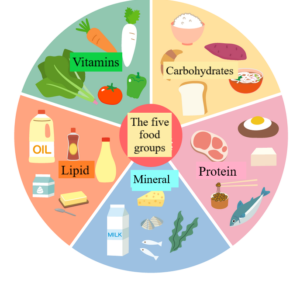
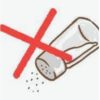 Watch out for salt, and eat well-balanced meals!
Watch out for salt, and eat well-balanced meals!
References:
・Introducing Your Baby to Food Kin-ikyo Sapporo Hospital
・Gill Rapley and Tracey Murkett. Baby-led Weaning: Helping your baby love good food.
・BLWをはじめよう!/ 日本BLW協会 著
Nobuko Kawamata M.D.


